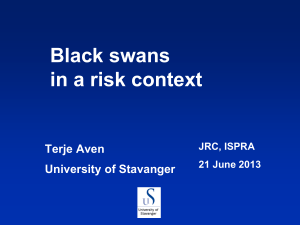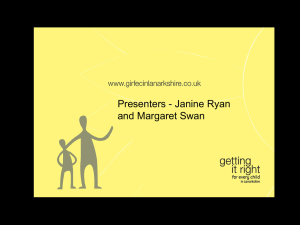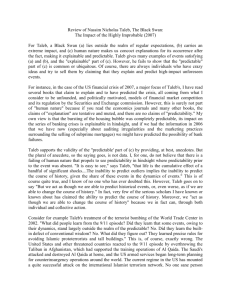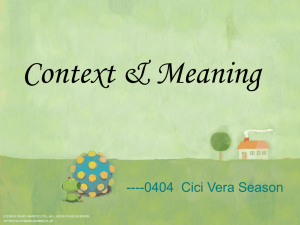Presentation – When Black Swans Aren`t: Holistically Training
advertisement
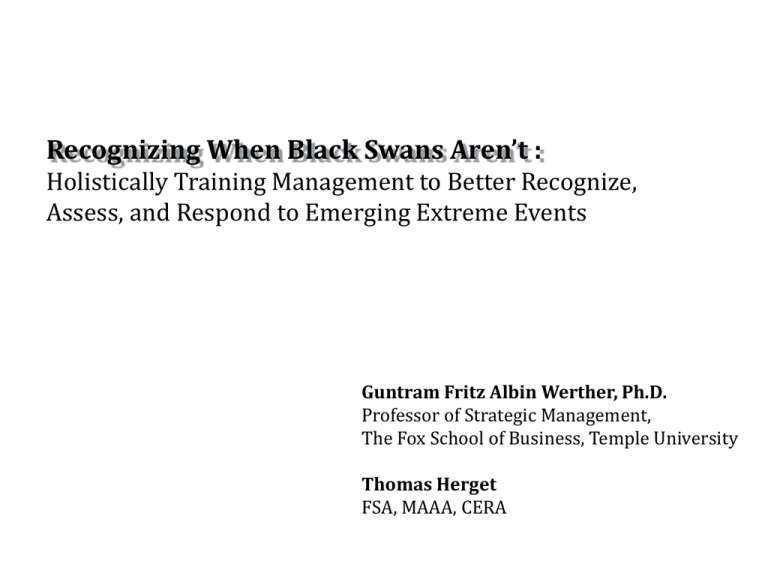
Recognizing When Black Swans Aren’t : Holistically Training Management to Better Recognize, Assess, and Respond to Emerging Extreme Events Guntram Fritz Albin Werther, Ph.D. Professor of Strategic Management, The Fox School of Business, Temple University Thomas Herget FSA, MAAA, CERA Our Goals Protect from Black Swan occurrences by building better ways to assess such event’s background characteristics, emergence dynamics, logics, and other foreseeable attributes Respond to the opportunities arising from Large Scale, Large Impact, Rare Events (LSLIRE’s) Contents Section 1. Definition of a Black swan - Black swan vs. LSLIREs Section 2. Assessing The Black Swan’s Worldview - Assessment of the strengths and weaknesses of Nassim Taleb’s book, The Black Swan Section 3. Moving Toward Solutions that Better Forecast Large Scale, Large Impact, Rare Events - Potential solutions to doing better recognition (forecasting) of emerging LSLIRE’s Section 4. potential solutions to doing better recognition (forecasting) of emerging LSLIRE’s - Difficult aspects of reducing the uncertainty related to better timing of emerging LSLIRE’s, and thus of better foreseeing emerging tipping or trigger points within a LSLIRE occurrence Section 1 : Definition of a Black Swan Learning Objectives • Learn the definition of a true black swan, and other definitions currently in use. • Learn cognitive, philosophical/theoretical, and practice implications of different usages of the black swan concept and its definitions. • Review Nassim Nicholas Taleb’s important influence upon this topic and review some professional statements of support and criticism. • Assess the differences between a black swan event and events that are massperceived black swans, but actually are not (they are predictable). • Review current methods for trying to detect true / mass perceived black swans. • Review why some of these methods have usually failed. • Review what is the state of the art for forecasting mass-perceived black swans. • Consider what a better forecasting solution looks like. Section 1 : Definition of a Black Swan Key Learning Points Since every model is biased, a wise choice of tools and the situation is needed. Any single-discipline identification approach (and any model too) is less capable of foreseeing and understanding human-involved complex system change than is a synthesis of multiple perspectives. It is not that models are wrong in a usefulness sense, but that every single assessment method frames one biased view into reality. Before a LSLIRE emerges, more than quantities change as internal and external relationships also change. LSLIRE forecasting involves assessing shifting system-specific patterns leading to insights about shifting forms. Gain broad general education and experience, do endless learning, do two-stage thinking, differentiating knowledge from comprehension. No accumulation of data, facts and relationships alone can solve the problem of successfully forecasting emerging futures Section 1 : Definition of a Black Swan How to define a true black swan? Any single-discipline approach is – any model too – less capable of foreseeing and understanding human involved complex adaptive system change than is a synthesis of multiple perspectives, cognitions, assumptions, and methods that are appropriate to that situation and that particular task. Insight The closer to a LSLIRE event’s emergence one comes, the more certain kinds of qualitative approaches when combined with arithmetic modeling approaches help in yielding better foresight, including yielding better LSLIRE timing foresight Holistic approaches are inherently superior to any single-discipline assessment M.C. Escher – Print Gallery 1956 Lithograph www.mcescher.com Section 1 : Definition of a Black Swan Mind Map Think of complex systems’ states as syndromes • a change of one variable can change the whole system • Everything in the system may still be within that system • But arrangements have shifted, and hence the system itself has changed Patternist : someone who views patterns of information as the fundamental reality M.C. Escher – Metamorphosis www.mcescher.com What kind of person, educated and trained how is best at detecting patterns, and changes in patterns? Section 1 : Definition of a Black Swan How to recognize pattern? Broad General Education/Experience Knowledge of how of how these factors differentially integrate to form their particular societal systems Endless learning Life-way and cognitive-philosophical orientation to gain better understanding Two-stage thinking Differentiate knowledge from understanding building integrative thinking skill leading to context specific synthesis Section 1 : Definition of a Black Swan Different Definitions of a Black Swan Black swan is a prospectively unpredictable large scale, large impact (extreme), rare, outlier event - events that arise from so far out on the probability tail as to be totally unpredictable Almost everything of significance around you might quality… Black Swan dynamics - totally unpredictable using current event recognition and assessment methods Merely as large impact, rare events missed by most people or as large impact rare events impossible to model due to the retrospective data nature of models Section 1 : Definition of a Black Swan We present large scale, large impact, rare event emergence recognition, assessment, and management, as a special case of futures forecasting, assessment, and change management We think one way to get better overall is to study people who are good at normal range forecasting as a way to approach discussion of the skills needed in better doing large scale, large impact, rare event forecasting Section 1 : Definition of a Black Swan Key Excerpts “… each model is likely to misguide when it is needed most: at its extremes.” “…synthesizing minds take time to develop … Aristotle required middle age before he would teach politics.” “… to be a better analyst … a broad, general education in human affairs and experience of many things is required for competence.” Section 2 : Assessing The Black Swan’s Worldview Learning Objectives • Learn important aspects of strong versus weaker versions of black swan thinking as it impacts real word change and the possibility of foresight • Learn key elements of connected order (syndromes) versus chance-based thinking and its basic implications for understanding real-word change Section 2 : Assessing The Black Swan’s Worldview Key Learning Points All models and methods are “wrong,” but that does not make them useless. Analysts usually do not adequately learn meta-rules, consider what they do not know, or achieve sufficient skepticism about change. Beware of qualitative shifts Black swans happen, but they are far less consequential to subsequent change than Taleb asserts. Embeddedness, entanglement, emergence, iteration, and connected orders (syndromes) are better ways to understand societal systems’ change than are randomness, chaos or chance Section 2 : Assessing The Black Swan’s Worldview Taleb is not correct… Taleb calls retrospective explanation fraudulent ↔ De Tocqueville’s example Taleb “wildly overstates the significance of Extremistan.” Taleb is correct… Many of Taleb’s points about the difficulty of rightly forecasting complex, large scale, large impact and rare events are correct “We don’t seem to be good at getting meta-rules…we lack imagination and repress it in others…we keep focusing on the minutia…[we misunderstand] the severe limitations to our learning from observations and experience and the fragility of our knowledge. “There is too much focus upon what we do know, and too little consideration given to impacts from what we do not know” Section 2 : Assessing The Black Swan’s Worldview Taleb’s Turkey Farm Black Swan Example: Werther cites real-life examples of black swans that aren’t. Do not see the world like a naïve turkey… Nothing comes from nothing. Complex system forecasting requires a sophisticated mindset and understanding. Synthetic thinking normally yields insight Proper situational awareness ● Lessons from history ● Multiple perspectives ● Reading implications and shifting contexts ● Other information integrating logics ● Cognitive shifting, intuition and insight into multi-player intentions ● The closer to a LSLIRE emergence one gets, the more the system’s behavior qualitatively changes ● Beware of qualitative shifts! Section 2 : Assessing The Black Swan’s Worldview Taleb’s End Lebanese Paradise Black Swan Example: 1970’s Lebanese Civil War unpredictable? Taleb’s position Successful insight, foresight, forecasting and assessment represent luck, intellectual fraud and impossibility Factual and cognitive objections to supporting Taleb’s black swan claim about the unpredictability of the 1970’s Lebanese civil war “Unknown Knowns”? facts that are well known, but you don’t know them The Lebanon strife in 1975 could be foreseen. Other Examples: An 1856 forecast of civil war in America pending the outcome of the 1860 elections Security expert Rick Rescorla (Heart of a Soldier by James B. Stewart) could so easily foresee an attack coming on his World Trade Center buildings; he actually practiced evacuations with his clients prior to 9/11. Section 3 : Moving Toward Solutions that Better Forecast Large Scale, Large Impact, Rare Events Learning Objectives Get exposure to the attributes of serially successful analysts, their practices and perspectives Achieve a more nuanced sense of the use and usefulness of failure Gain a prefatory understanding of holistic perspectives and how they aid in LSLIRE recognition and assessment Section 3 : Moving Toward Solutions that Better Forecast Large Scale, Large Impact, Rare Events Key Learning Points 1 of 2 Excellence in understanding complex systems is a sustained enterprise with endless topping off. Being excellent, even in familiar waters, is serious work. You can’t recognize a rare event if you don’t recognize what normal looks like in each system. Master multiple perspective thinking and analysis from different cognitive assumptions, especially integrating psychological, sociological and philosophical perspectives and their changes within hard data. Don’t’ predetermine or prejudge which variables are context-relevant. See the fit of things; from this, better judge their potentials and limits. Most excellent complex systems forecasters have varied, not specialized, backgrounds. A serially-best analyst thinks independently; this often means being contrary to the herd. You must have the courage to judge herds and think independently of them. Section 3 : Moving Toward Solutions that Better Forecast Large Scale, Large Impact, Rare Events Key Learning Points 2 of 2 To recognize LSLIREs, you must avoid being a casualty of the tendency to protect the status quo. Focus on patterns first, then facts only within the context of these patterns. Grow antennae; recognize things and processes in environments other than one’s own. Learn to use failure creatively, especially that of others. Triangulation of suddenly deviating multiple method outputs provides warning of incipient pattern change in a formerly predictable system. Repeated triangulation and polling of multiple methods against their normal readings can illuminate type and direction of change. Avoid predetermining topics and variables of interest; study what comes. Learn the embedded architecture of systems and how that structure limits or favors options and possibilities. Learn the entanglement features of systems and how that shapes them going forward. Section 3 : Moving Toward Solutions that Better Forecast Large Scale, Large Impact, Rare Events You cannot recognize a rare event if you don’t recognize what normal looks like in each different complex system, and among them Normal Industry-Level Foresight and Assessment at Expert Levels of Achievement Examples: • Mark Weintraub (eight time honoree) saw favorable industry and international trends coupled with “…dramatic structural change where producers are managing supply better than in the past.” • Mike Linenberg (eight time honoree) : “…inside out knowledge of the industry helps him home in on broader trends…[says] there are many data points to parse…[but] taking [a] data point and the industry’s general restructuring in recent years, Mr. Linenberg sees a sector on the cusp of investability.” • Bob Glasspiegal (eight-time honoree) : speaks of industry “headwinds…[of what] matters to life insurers…scrutinizes industry data closely; talks to brokers, agents and other sales people; and draws on a long list of former company executives and employees for insights…[he judges that firms/industry face the] same difficulties as last year…[and says that] Trying to manage the time to zero on the important variables to make money is a bigger challenge.” Section 3 : Moving Toward Solutions that Better Forecast Large Scale, Large Impact, Rare Events Deep and specific industry/firm knowledge Context of specificity and across time, macro-, micro-, firm specific, and industry trends Within their industry’s changing contexts Syncretism: seeing the forms change Willingness to go against the consensus: to non-confirm Section 3 : Moving Toward Solutions that Better Forecast Large Scale, Large Impact, Rare Events Common Factor Discussion of Industry –Level Change Recognition and Forecasting Age Excellence in understanding complex systems and forecasting is a sustained, sunk-cost enterprise with endless topping up. Building up synthetic sense (common sense) comes with time. Sensible synthetic capacity is not something one has early or learns quickly so much as something one becomes capable of given sustained learning and experience. Psychological Perspectives and Cognitive Foci Master multiple perspective thinking and analysis from different cognitive assumptions, especially integrating ‘soft’ psychological, sociological, and philosophical perspectives and their changes with the ‘hard’ data. Find, Don’t Pre-Determine, the Relevant Context-Specific Variables Don’t predetermine or prejudge which variables are context relevant. Think like you drive and live: constantly integrate and reconsider. Macro-, Micro-, Industry-Firm, and Context Specificity and Change Insight Integration See the ‘fit’ of things, and from this, better judge their potentials and limits, possibilities and impossibilities. This is profiling more than modeling. Section 3 : Moving Toward Solutions that Better Forecast Large Scale, Large Impact, Rare Events Common Factor Discussion of Industry –Level Change Recognition and Forecasting Multiple Experiences and Jobs Most excellent complex systems forecasters have varied, rather than specialized, learning, work, and experiential backgrounds. Skepticism Human-involved complex system’s change shows specific, but different among-systems, embedded, entangled change process characteristics. If you cannot foresee a plausible and likely path, you are wishing and/or guessing. The courage to be a Contrarian A serially best analyst thinks independently, and this often means being contrary to the herd while knowing where the herd is. Avoiding Being a Total Cassandra by Using Normal Methods, Normal Analyst’s Perceptions, and Mainstream Firm Behaviors to Ground Your LSLIRE Judgment The herd-like behavior of analysts and their linked near-event failure to foresee the emerging, changing landscape is very useful in helping illuminate an emerging LSLIRE and in helping time the event’s ‘trigger point’. Section 3 : Moving Toward Solutions that Better Forecast Large Scale, Large Impact, Rare Events Change Recognition is about Familiarity, and Learning Familiarity is the Game: It is the study of the repatterning of patterns Comparative syncretism Applying why Forecasting Experts are Patternist : Problem with Facts Given all the facts, it becomes harder still, not easier, to know which facts matters when, how, why and in what morphing context? Holistic patternist Learn to recognize things and processes in environments other than one’s own and among different interacting environments Broad and deep knowledge and understanding of similar ‘board’ Hmmm… Still not enough to get better at foreseeing LSLIRE, rare and relatively unfamiliar areas to everyone Section 3 : Moving Toward Solutions that Better Forecast Large Scale, Large Impact, Rare Events Some techniques of Pre-Event Normal Crisis Pattern Change Recognition 1 Use Multiple Methods Arrayed Around the Assessment Target Each model and qualitative method fail differently This dynamic array of method failures can be used to • Recognize impending system instability • Triangulate, using iterative polling of the many different method’s outputs, on underlying, even causal, issues. 2 Triangulation and Patterning Emerging Change • Triangulation of suddenly deviating multiple method outputs provides one kind of warning of an incipient large-scale pattern change • Repeated triangulation and polling of multiple methods against their normal readings can illuminate type and direction of change 3 Folding In and Laying the Onion • “Many paths to the truth” – Avoid pre-determining • Individual pattern that does not fit becomes more obvious Section 3 : Moving Toward Solutions that Better Forecast Large Scale, Large Impact, Rare Events Some techniques of Pre-Event Normal Crisis Pattern Change Recognition 4 Consider a Preference for Qualitative Insights to See Change Lacunae Each model and qualitative method fail differently • Qualitative perception on new farm activities - Taleb’s turkey farm example • “the cases of people taking justice into their hands are becoming more and more common”. – outbreak of Civil War 5 Focus on Seeing Undergirding Socio-Psychological and Style Changes • When foundational psychologies, rules and ways change, system change 6 Use an Understanding of How Things and Processes are Embedded • Learn the embedded architectures and ways of systems or topics of interest, and how that limits or favors options and possibilities 7 Learn to Understand How Things and Processes are Entangled • Cultures, societies, families, individuals, firms, organizations, and so forth are entangled systems: they always carry their legacy forward Section 3 : Moving Toward Solutions that Better Forecast Large Scale, Large Impact, Rare Events Key Excerpts “Willingness to nonconform is critical to LSLIRE recognition. …” “The proper process … is an investigative frame of mind, rather than being merely analytical.” “Members of a herd follow the things in front of them.” “… producing just another batch of experts who are ignored or punished is not a useful outcome of this discussion.” “One problem with facts is that there are too many of them … their usefulness varies temporally.” “Trusting an individual fact is a dangerous thing since some self-interested person created it … whereas patterns accumulate from multiple sources and are thus far harder to ‘cook.’” The best of Wall Street “integrated psychology and other human factors with many technical ones to win.” “… use a multiple-methods approach to provide early warning of system change.” “All methods bear weaknesses, biases and errors, but different methods bear different weaknesses, biases and errors.” Section 4 : The Better Recognition and Timing of an Emerging LSLIRE Learning Objectives • Learn some techniques for better recognizing LSLIRE emergence. • Learn some ways to personally gain comparative advantage from the fact that most analysts will fail to recognize an emerging LSLIRE. • Learn why pattern-based intelligence assessment is easier than informationbased intelligence assessment, especially in more complex systems. • Learn the value of intellectual conversation, especially as applied to proposed change agendas. Section 4 : The Better Recognition and Timing of an Emerging LSLIRE Key Learning Points Mainstream analysts' failure dynamics teach you how to time the emergence of a LSLIRE. Ideas, goals and the constrained ways of normally achieving them are as important to understand as facts and figures. More complex systems are harder to change, making them easier to forecast as 'big picture' futures relative to simpler, more volatile systems. You, and your enemy, can know what your system will do. Information-based intelligence is often different and more confusing than patternbased intelligence. For a default pathway position, stay with intellectual conservatism and adjust as more is contextually learned. Gain entry at any point in the information flow. Learn humanity’s reasons, ways and forms. Section 4 : The Better Recognition and Timing of an Emerging LSLIRE LSLIRE Insight from Big, Bigger, and Biggest Data ? “Do you need to know all the atoms in the stream, and all their potential interactions, to predict which way the stream is flowing, or how to change its flow?” “If you measure more things with technology, more correlations will emerge. Making sense of them – forming understanding – is another task entirely.” “The challenge is to figure out how to analyze these connections in this deluge of data and come to new ways of building systems based on understanding these connections.” We arrive in the end, even with better methods and more innovative use of old ones, at human analyst improvement Section 4 : The Better Recognition and Timing of an Emerging LSLIRE LSLIRE Recognition Approach 1 : Measure the differential failure of mainstream analyst’s judgments - Focusing on how using specifically arrayed multiples of models and methods that each behave and fail differently just prior to a normal-range crisis LSLIRE Recognition Approach 2 : “Beyond analysis” familiarity and understanding of “pattern qualities” - “What makes men foolish or wise, understanding or blind, is the perception of those unique flavours of each situation as it is, in its specific differences – of that in it wherein it differs form all other situations, that is, those aspects of it which makes it insusceptible to scientific treatment, because it is that element in it which no generalization, because it is a generalization, can cover.” – Sir Isaiah Berlin Section 4 : The Better Recognition and Timing of an Emerging LSLIRE Some Tricks of the Trade for Holistic Assessment, Profiling of System’s Change Processes, and its Harmonies (Emergence/Entanglement) in LSLIRE’s : ‘Big Picture’ Patterned Response Reliability is Counter-Intuitive to Information-Based Predictive Notions in Complex Adaptive Systems Information-based Intelligence is Often Different and More Confusing than Patternbased, Change Profiling-Based Holistic Intelligence Prefer Intellectual Conservatism as a Default Pathway Position; adjust as more is contextually learned Gain Any Entry Learn humanity in its reasons, its ways, and forms The qualities of intuition based on prior learning and experience, of insight, iterative integration to see patterns, judgment, and whole-system synthesis are known to be necessary to transition from information to knowledge to understanding, and to foresee emerging embedded and entangled factors in specific contexts of syndrome change. Section 4 : The Better Recognition and Timing of an Emerging LSLIRE Technology and modeling are invaluable complements to building the best theory and practice of LSLIRE recognition and assessment, and to the management of downstream implications. Machines are a valued complement to a more than adequate complex human nature, rather than a replacement for it. Learning, experience, intuition and judgment matter. Imperfect though knowledge and understanding be, every reasonably competent person negotiates life daily and forecasts reasonably well in his or her familiar environment. Why should better black swan to large scale, large impact, rare event recognition and forecasting be any different? Section 4 : The Better Recognition and Timing of an Emerging LSLIRE Key Excerpts “Some models go crazy, such as Goldman Sachs’ models showing ‘25 standard deviation moves, several days in a row.’” “Behavioral science is not for sissies.” The status quo usually punishes deviant opinion. “… often regulators and society ignore clear warning.” Referring to the financial crisis, “… market makers and analysts had informational problems during 2005–2008, but not before. As a result, analyst ratings diverged significantly after 2005, as they could all no longer see the same play.” “Like economists who predicted 10 of the last two recessions …” situational awareness is better than cluelessness. “Our methods worked until they didn’t” is the normal LSLIRE state of forecasting. Werther looks closely at Taleb’s closing example. Taleb said, had 9/11 been conceivable, it would not have happened. Thus it was a black swan to Taleb. But it was a foreseeable event (a LSLIRE) to Rick Rescorla and to others who were on the trail. Failure to act is not the same as failure to foresee.
